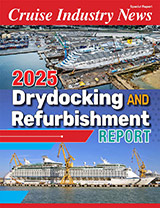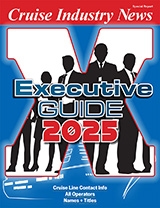Carnival Corporation reported net income of $236 million, or $0.30 per share, on revenues of $3.2 billion for its first quarter ended Feb. 29, 2008, compared to net income of $283 million, or $0.35 per share, on revenues of $2. 7 billion for the its first quarter last year.
Chairman and CEO Micky Arison attributed growth to the continued recovery in the Caribbean for the company’s North American brands and its European brands performing well, combined with the strengthening of the euro and the sterling, as well as a 10.5 percent increase in capacity and higher cruise revenue yields.
The drop in net income was attributed to higher fuel costs, which were up 66 percent over last year and reduced Q 1 earnings by $0 .19 per share, according to a prepared statement.
Fleetwide capacity was up 10.5 percent and European capacity was up 20.6 percent, including Carnival’s new Spanish brand, Iberocrucros. North American capacity was up 5.7 percent year-over-year.
Ticket yield was up 7.7 percent fleetwide, according to Carnival, with North American brands up 7 .1 percent, driven by the recovery in the Caribbean.
In China, Costa Crociere’s yield was reported to have improved significantly, with pricing and occupancy up, compared to last year, as result of shifting passenger sourcing.
However, onboard spending has shown some softness, especially among the contemporary brands. The advance bookings for the remainder of 2008 are ahead of last year in terms of both occupancy and pricing, according to Carnival.
However, higher fuel prices are expected to reduce full year 2008 earnings by $0.65 per share, compared to 2007. Still, the company’s earnings guidance for 2008 is in the range of $3.00 to $3.20 per share, compared to $2.95 in 2007.
Carnival also noted that the different brands had a total of 10 drydocks in Q1 of this year, compared to four last year, which resulted in an additional $21 million in expenses.
And although there are inflationary pressures in all cost areas, according to Carnival, the company has managed to keep costs flat year-over-year.
For 2008, it expects all controllable costs to be down on a passenger cruise day basis, except for fuel and currencies.
Commenting on the booking environment, Howard Frank, vice chairman of Carnival, said that bookings are nicely ahead of last year. He said that the Wave Season was slightly lower than in 2007, but that it was due to less inventory being left to sell and due to higher pricing.
“The (forward) booking picture now is quite optimistic,” Frank said, adding that the slowdown in onboard spending has already been worked into the earnings guidance for the year.
Frank said that the reduced guidance for the year was primarily because of the slowdown of onboard spending.
The new guidance is approximately a IO percent reduction from the guidance given earlier this year. The revenue from the fuel supplement has been deferred for the time being. “Perfect Storm” “It is clear now that the economy is starting to affect us,” Frank said. “But the consumers are still looking to go on vacation.
“Will a recession affect the industry?” Frank asked and answered: ”yes.” What the industry is enduring, according to Frank, is the perfect storm. He referred to the fuel prices that continue to go up; to the collapsing housing market; to banking issues; increased unemployment; and the lowest consumer confidence level in recent times. “We are impacted by all of this (bad news), but we are booking as well as we ever have,” added Arison.
Q2
For Q2, North American capacity is up 3 percent over last year, according to Frank, with 52 percent of the total capacity deployed in the Caribbean, compared to 55 percent last year, and 13 percent on the Mexican Riviera, compared to 11 percent last year. Overall, occupancy is up 1.5 percent, with pricing well ahead of last year, Frank said.
“The Caribbean has rebounded,” Frank said, noting that he expects that trend to continue. For the European brands, the capacity is up 23 percent over last year, with occupancy running slightly behind, but with pricing up. Caribbean winter deployment is about 16 percent, the same as last year.
Pricing on European itineraries are up, but pricing for other itineraries is flat, Frank said. Carnival’s earnings guidance for Q2 is from $0.42 to $0.44, compared to $0.48 last year.
Q3
For Q3, the fleetwide capacity will be up 8.8 percent over last year. Occupancy is up slightly and pricing is well ahead.
North American capacity is up 2 percent, and 36 percent of the total capacity will be deployed in the Caribbean during Q3, compared to 40 percent last year; 29 percent will be in Alaska, the same as last year. Twenty-two percent will be in Europe, compared to 18 percent last year.
Frank said that occupancy was up fleetwide and that pricing was up “slightly.” In Alaska, however, occupancy and pricing are down to flat, year-over-year, but that Alaska bookings tend to pick in April and May. For European cruises by the North American brands, both occupancy and pricing are down, compared to last year, according to Frank. With more capacity in Europe being marketed in North America, Frank said that the cruise lines’ air/sea programs have committed airlift, but admitted that the higher cost of air travel could deter people who book their own flights.
The European brands are seeing a capacity jump of 24 percent over last year, with basically all of it being deployed in the Mediterranean and Northern Europe. Despite the increase in capacity, occupancy is only slightly lower than last year, with a flat yield forecast.
Added Arison: “You must see Europe in perspective; our capacity is up more than 20 percent, while occupancy and yields are flat. So we are doing beautifully.”
Frank said there is some slowdown in the booking pattern for Q3, but that the quarter will be very good, since most of the business has already been booked.
Q4
The fleetwide capacity will be up 8.7 percent, with occupancy running 4 percent ahead of last year at this point, and with pricing slightly head.
The North American brands will have a 5 percent capacity increase, with 42 percent of their total capacity deployed in the Caribbean, compared to 46 percent last year; 12 percent in Europe, compared to 10 percent last year; and 12 percent on the Mexican Riviera, the same as last year.
“The North American picture at this point is looking quite good,” Frank said. For the European brands, capacity will be up 18 percent over last year with 77 percent deployed on European itineraries and 10.5 percent on trans-Atlantic voyages.
Frank said there are no plans at the moment to retire ships or move more ships to joint ventures. A second ship is moving to Iberocruceros in 2009.
Arison commented on the luxury market and said that while it has great potential, it is a very small market and must be tapped cautiously. Noting Seabourn Cruises Lines’ building program, Arison called it very aggressive to introduce three new ships to the market over three years. He also said that the brand is very pleased with the early booking indications for the new Seabourn Odyssey.



